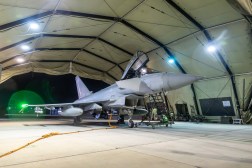Central Command looks to expand its counter-drone arsenal in the aftermath of Operation Rough Rider

Aircraft armed with advanced laser-guided rocket systems took out a little under half of the one-way attack drones the Houthis launched against military and commercial vessels during the U.S. military campaign that unfolded between March and May in and around the Red Sea, Gen. Erik Kurilla told lawmakers Tuesday.
At a House Armed Services Committee posture hearing, the U.S. Central Command commander shared new details about that operation and said it underscores the military’s intensifying need for more and better counter-drone technologies and software.
“We absolutely need to be putting more work into directed energy [and] high-powered microwaves, I think, are some of the innovations that have come out of this since Operation Rough Rider. About 40% of the drones shot down were shot down by something called Advanced Precision Weapon Kill System, a laser-guided 2.75-inch rocket fired off our F-16s or F-15s. That’s a $25,000 munition going against a roughly $50,000 or $100,000 drone — that is an Iranian-provided drone,” Kurilla said.
Iran-backed Houthi fighters based in Yemen kicked off their attacks against vessels traversing crucial international shipping routes near the Red Sea in 2023. They indicated the disruption was meant as a form of protest of America’s support for Israel’s military actions in Gaza.
Early into his second administration, President Donald Trump initiated Operation Rough Rider to dismantle Houthi infrastructure and leadership in the region. Trump announced an end to the operation in early May, following an agreement between America and the Houthis — brokered in part through the Omani government — to suspend the strikes.
Operation Rough Rider cost the U.S. an estimated $1 billion, lawmakers pointed out at the posture hearing. It also resulted in the loss of multiple high-dollar military drones and fighter aircraft.
“The president gave us a very specific mission, which was to get the Houthis to quit shooting at American ships. Six months ago on 12 November 2024, was the last time a destroyer went through the Bab-el-Mandeb. It was attacked 17 times with anti-ship ballistic missiles and anti-ship cruise missiles and [unmanned aerial vehicles or UAVs]. In the last week, we put four destroyers back through the Bab-el-Mandeb,” Kurilla said.
After the conclusion of Rough Rider, however, Centcom is “still defending Israel with” its Terminal High Altitude Area Defense (THAAD) system against ongoing assaults from the Houthis, which remain under the foreign terrorist organization designation by the U.S.
In the operation’s aftermath though, one major lesson the command learned, as Kurilla put it, is that “software is a weapon” that is rapidly changing the character of warfare.
“Our ability to do Combined Joint All-Domain Command and Control, the things that we are doing with software — it’s amazing. We have advanced that. We have engineers every day making improvements on our ability to do that. It’s a warfighting headquarters,” Kurilla said.
Software is also driving significant transformations in ballistic missile defense on the contemporary battlefield, the commander noted.
“The same thing, I would tell you, as it comes to counter-UAS as well. We are making changes to the Navy’s software on the SPY radars based on what we’re seeing,” Kurilla told the committee.
When asked by lawmakers to recommend the top weapons capabilities he views they should most quickly invest in, the commander repeatedly pointed to counter-drone systems, calling them the “number one” in-demand tool at this time.
“We’re only going to see the systems get smaller, more lethal. [On] the electromagnetic spectrum, we try and jam that. That’s why Ukraine and Russia went to fiber optics — going out to 40 kilometers with fiber optic drones — you can’t jam that. So those are the things I would ask for right now, the counter-UAS [and detection capabilities]. I think we need to put aerial [Inverse Synthetic Aperture Radars or ISAR] for low-radar cross section to be able to pick up, elevate it, and then [use] ballistic missile defense,” Kurilla said.






